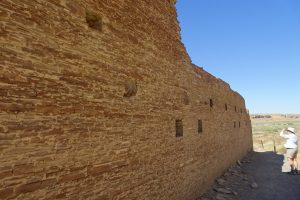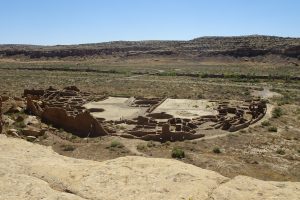11-12 Sep: Chaco Culture National Historical Park was our number one goal of sights to see in New Mexico. On the drive south from Colo. we stopped for lunch at the Farmington, N.Mex. visitor center & museum, where there was a beautifully landscaped picnic area and a traveling exhibit of exquisite quilted wall hangings on the theme of the Rio Grande River. We browsed a couple of Navajo art galleries and selected a small Navajo rug for our living room. Our Chaco adventure truly started as we traveled the long unpaved road from a major state highway in toward the park. For a while it was not too bad, merely a somewhat rough gravel road, but after leaving the section maintained by the county, it became atrociously rough and washboarded.
The tortuous ride was worth it, though. The “great houses” built by the Ancestral Pueblo people in the late first and early second millennia were expertly crafted of sandstone bricks and mortar into multi-story pueblo-style apartment complexes, the largest and best example being Pueblo Bonito. Despite the arid environment, the Chaco Culture thrived as a major ceremonial population center with trade connections to places as far away as today’s southern Mexico.


13-14 Sep: Between Chaco and our next stop, Bandelier National Monument, we traveled through canyons, wooded mountains, and along the rim of a large, ancient volcanic caldera by way of the very scenic Highway 4. The Jemez volcano erupted at least twice in violent eruptions 600 times the force of the 1980 Mount St. Helens eruption. The emptied magma chamber collapsed, forming the 14-mile wide Valles Caldera. Ash deposits from Jemez and other volcanic eruptions of the period compressed during subsequent millennia into beds of volcanic tuff, a fairly soft conglomerate rock, over 1,000 feet thick in places.
In the Frijoles Creek valley, the Ancestral Pueblo built “talus” dwellings at the base of the steep cliffs by hand digging small caves (“cavates”) into the tuff for inner rooms and constructing outer rooms in the pueblo style using blocks of tuff. The Main Loop hiking trail in the monument passes a traditional pueblo on the valley floor as well as talus dwellings along the base of the cliff, with numbered stops corresponding to an informative pamphlet explaining the geologic, cultural, and natural history along the way. The Long House section of talus dwelling ruins shows clearly the hand-carved holes where roof and floor beams were once erected for two and three-story dwellings in a continuous structure along the base of the cliff.
